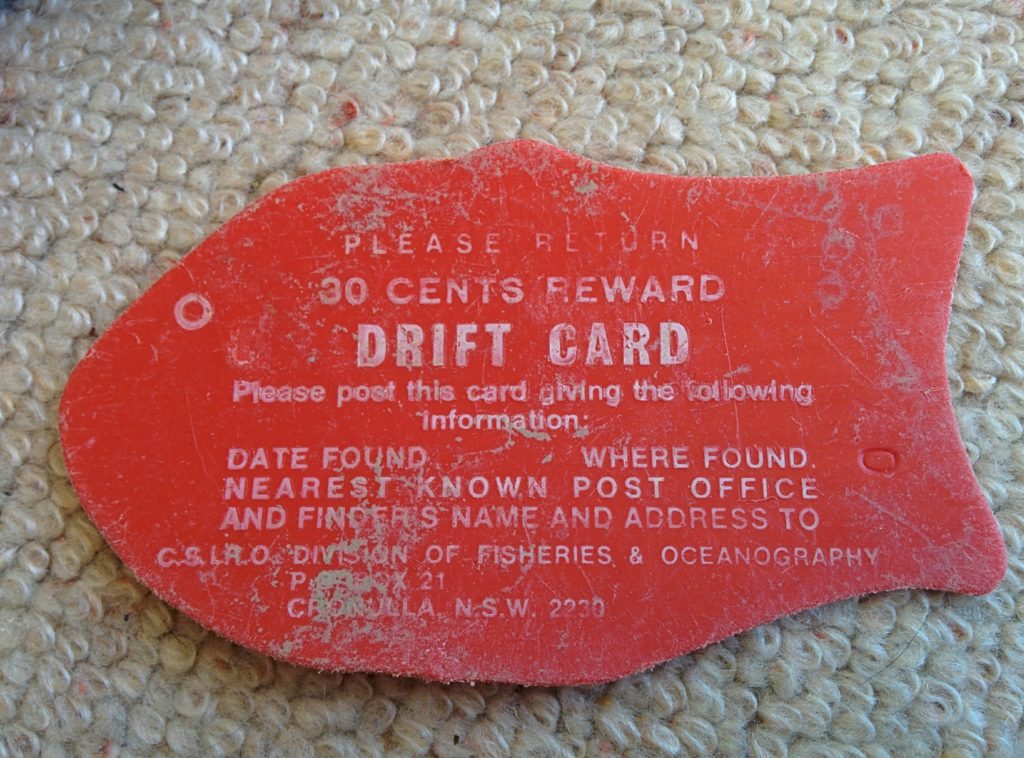A casual stroll along the beach has helped to uncover a relic of our data collection past.

Our drift cards were used to calculate and model ocean currents around Australia and other parts of the world. Image – Fiona Hayter & Jason Milward.
The emergence of the information age with its high tech sensors, high powered computers and digital storage has given us almost instantaneous access to unimaginable amounts of data. It wasn’t always this simple though, with even the most ingenious methods sometimes requiring weeks or months before results could come full circle.
One such data-collecting relic was recently discovered by Fiona Hayter and Jason Milward among the rocks near the Ethel Shipwreck about three hours west of Adelaide while the pair were on holiday. It doesn’t have a single sensor or even require batteries, and it can even fit into the palm of your hand — it’s known as a drift card.
Fiona says the couple was fortunate enough to notice the drift card among the rocks with its peculiar design and bright colours catching their attention.
“We found it just after a big storm went through the area, most of the coastline was eroded, which is probably how we found it.”
With a return address to our Division of Fisheries and Oceanography in Cronulla (which hasn’t been around since 1981), the small piece of equipment was used for decades to calculate and model ocean currents around Australia and other parts of the world.
Using a drift card was simple: you’d pick a location ensuring you’ve recorded the exact coordinates and then you’d just drop it into the ocean. The method relies on people finding the cards and returning them providing information on where it was found which is then used to piece together data to model the currents.

Fiona and Jason found our drift card near the Ethel Shipwreck at Marion Bay. Image – Fiona Hayter & Jason Milward.
The cards were used during the 1960 and ’70s with thousands being released in the oceans surrounding Australia and some parts of South Africa. According to our research technician Matt Lansdell, we still get around two or three drift cards returned every year.
“Unfortunately this one won’t provide any useful information concerning drift patterns, due to the length of time between release and when it was returned,” Matt said.
“We don’t know what happened during this time: the card could have been submerged beneath a sandbar or even snagged along a reef, because of this it’s only those recovered shortly afterwards that have relevant data.”
Nowadays information is gathered at an unprecedented rate with the Argo system collecting information on the direction, speed, temperature and salinity of the ocean currents before transmitting the information to research institutions across the world.

Matt however still encourages citizen scientists and eager beach combers to return any of our drift cards, since returned archival tags have, in the past, contained valuable information.
Although you won’t be seeing drift cards make a return any time soon it’s still an oddity to see past technology survive into the present day, and just to prove that they’re in it for the love of scientific discovery and not money, Fiona and Jason have declined the 30 cent reward offer upon returning the card.


29th July 2019 at 12:06 am
Hello, I found another one of these drift cards here in Augusta, Western Australia while I was doing a beach clean-up yesterday. Mine still has a legible serial number and the reward is 70 cents so I am guessing it was released at later date than the one Fiona and Jason found. There has been a significant amount of dune erosion at the beach I found it on so I am speculating that it has been recently uncovered after spending many, many years buried in the dune system. If you can let me know who to email a photo of it too, and/or an address to send it back (as I assuming the address on it may well be out of date) that would be greatly appreciated. Thanks so much, Renee
9th February 2017 at 2:33 pm
I wonder how many ended up in the gullets of seabirds and other wildlife? The cards don’t seen very biodegradable. It’s not just the tech that has changed, it’s unlikely this would get past a research ethics committee nowadays! Awesome story.
9th February 2017 at 10:57 am
So where and when was this drift card released?
9th February 2017 at 2:27 pm
Matt – due to the serial number on the card being worn and unable to be read, it wasn’t possible to say exactly when the card would have been released, however it was likely in the very late 1960’s or early 1970’s. The release location is similarly uncertain, but cards were extensively released off Perth and the SW corner of Western Australia. This one was likely released from that area and carried eastward on the Leeuwin current.
20th December 2016 at 10:16 am
Excellent example of how plastic never goes away – over 40 years old and still in a similar form as it was when it was released.